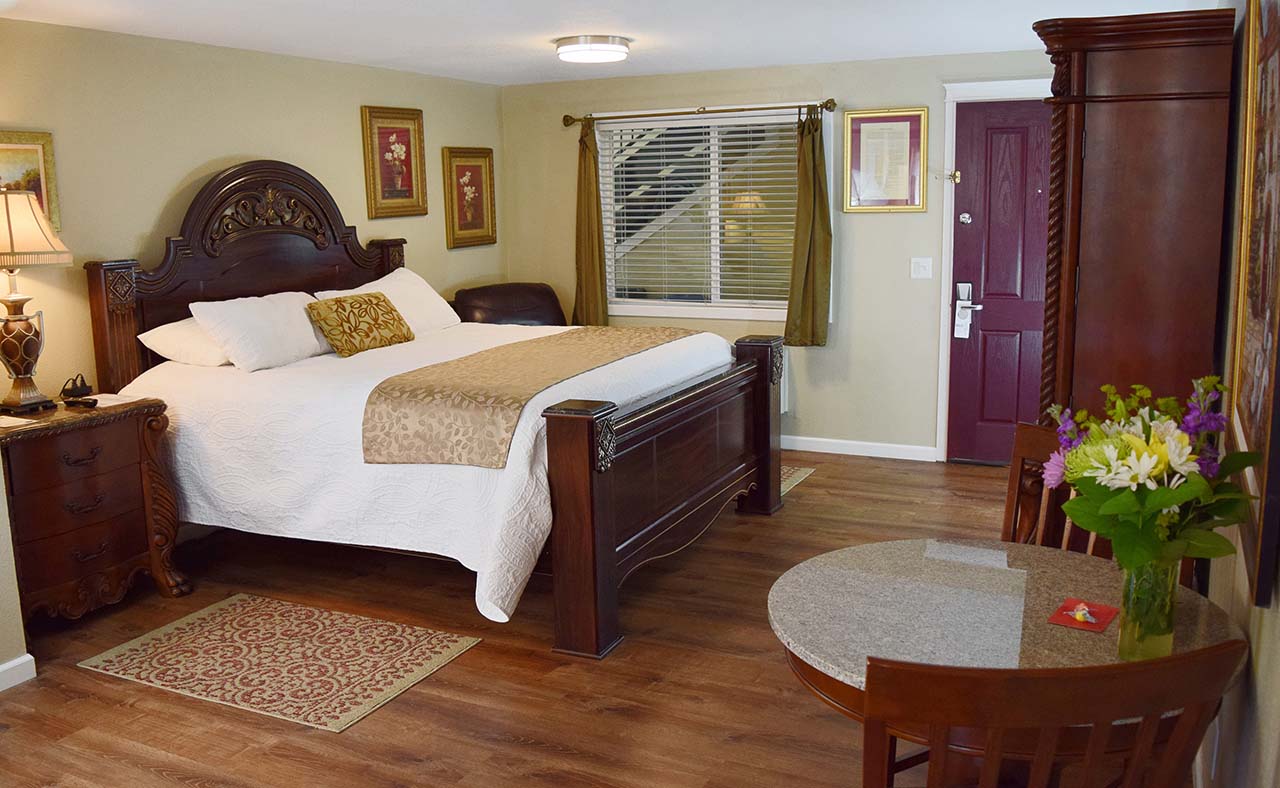
The June Drake Room
Search Rooms
If you have ever viewed a photograph of historic Silverton, it was most likely taken by Silverton’s foremost commercial photographer, June D. Drake. But Drake was more than an eminent photographer; he was a historian, a chronicler of the life and times of a community, a strong advocate for the preservation of nature, and a collector of mementos from all over the world.
Room Amenities
- One King Bed
- No Pet Allowed
- Full Kitchen
- Bathroom With Walking Shower
- Smart TV
- WiFi Internet
- Heat / Air Conditioner
- Alarm Clock /
- Coffee Maker
- Hair Dryer
- Iron & Ironing Boards Available
June D. Drake was born in 1880 in Marquam, Oregon where his pioneer parents had settled in 1852. The family moved to Silverton 1889, into a new home at 401 South Water Street. In 1904, June married Elizabeth Schoenfield of Salem and they settled into a home he had built at 409 South Water Street, next to his parents. This home was the first new home constructed in Silverton to be plumbed and wired with electricity. (Incidentally, both homes still stand today.) The couple had two children, Charles and Ardith. Drake was active in the community, serving as Secretary of the Silverton Chamber of Commerce and on the city council.
In 1904, Drake and his brother Emery R. Drake bought out the pioneer Silverton photographer William L. Jones (who had photographed subjects beginning in the 1880’s), and set up business for themselves. Four years later, Emery left the partnership to move to California and June continued the business himself until he retired in the 1950’s. The first studio was located on the second floor of a building on North Water Street, but it was destroyed by fire in 1908 and thousands of precious negatives of early Silverton scenes were lost. A second, temporary studio was built in 10 days with the help of local townspeople at 311 North Water Street. Drake’s final studio was a concrete building constructed in 1911 at 303 North Water Street, across from the Silverton Inn and Suites. This studio was memorable in that it served as a showcase for his photographs and as a museum for the dozens of interesting objects he collected from the community’s history. Drake had them on display for the public during the city’s centennial in 1954.
The characteristics of Silverton’s mountains, prairies, logging, farming and enterprising people all enter importantly into the life and career of Drake and his photography. Drake’s photography style is unique or at least unusual in these respects:
• Drake’s photographs display an intense devotion to his home town and to the neighboring small towns. They cover not portraits alone, but the whole story of the town and surrounding countryside: its factories, mills, farms, fairs, fire, floods, parades, picnics, buildings, homes, roads, store interiors, shops, stables, the coming of cars—regular life in the city. His images record not only the activities of the town but also the entire working life of June Drake and his studio;
• He used natural light almost exclusively for interiors, studio shots and commercial photos, preferring to wait until “the light was right.” Scenes of buildings and streets were characteristically taken in early morning diffused light when there were no people about or deep shadows. And Drake managed to avoid weddings (and funerals) in churches – he photographed brides and grooms only in his studio;
• Throughout his long career, the Drake Bros. Studio was almost entirely a one-man operation, where Drake went out on location, took the pictures, developed the plates, did the re-touching, printing, mounting and record keeping;
• Glass “dry plate” negatives in the large formats (5×7 and 8×10) were used almost exclusively by Drake, with the resulting detail so fine that dating can often be deciphered from the fine grain images of car license plates or wall calendars in the view; he preferred the bulky and heavy plates long after pack film and cut film became common;
• Drake was a skilled artisan and artist as shown by his expert retouching of negatives and coloring of prints but he also had the ability of an accomplished outdoorsman as he endured great difficulties to obtain scenically superior views of the wondrous countryside. (Ron English)
When Drake was asked what he considered his greatest achievement, he replied without hesitation, “Silver Falls State Park.” As early as 1900, Drake began photographing the Falls—he hired men to cut pathways so he could better document and preserve their spectacular beauty. He created publications advertising the splendor of the area and even purchased several hundred acres himself in order to help secure the land. His untiring efforts were instrumental in protecting the area from logging and helped to convince legislators to create a state park. In July of 1933, the area was opened to the public and dedicated as Silver Falls State Park. Drake’s name still appears on landmarks in the area as recognition of his perseverance.
Drake gradually retired from photography in the late 1950’s. He died in 1969 and is buried in Silverton Cemetery.
Sources: Article by Jeff Brekas; Handwritten Notes by Ron English

